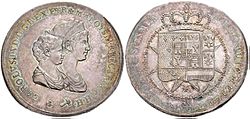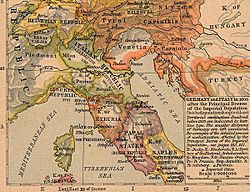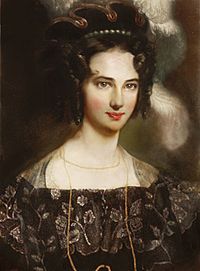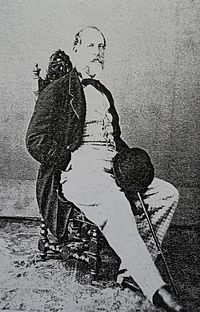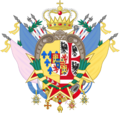Charles II, Duke of Parma facts for kids
Quick facts for kids Charles Louis |
|||||
|---|---|---|---|---|---|
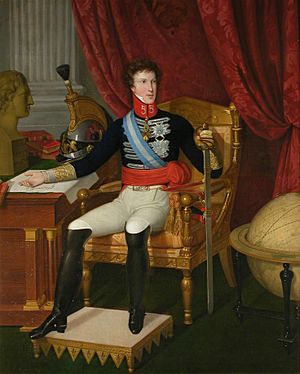
Charles II, Duke of Parma, c. 1850
|
|||||
| King of Etruria (as Louis II) | |||||
| Reign | 27 May 1803 – 10 December 1807 | ||||
| Predecessor | Louis I | ||||
| Regent | Maria Luisa of Spain | ||||
| Duke of Lucca (as Charles I) | |||||
| Reign | 13 March 1824 – 17 December 1847 | ||||
| Predecessor | Maria Luisa | ||||
| Duke of Parma and Piacenza (as Charles II) | |||||
| Reign | 17 December 1847 – 17 May 1849 | ||||
| Predecessor | Marie Louise | ||||
| Successor | Charles III | ||||
| Born | 22 December 1799 | ||||
| Died | 16 April 1883 (aged 83) | ||||
| Spouse | Maria Teresa of Savoy | ||||
| Issue |
|
||||
|
|||||
| House | Bourbon-Parma | ||||
| Father | Louis, King of Etruria | ||||
| Mother | Maria Louisa, Duchess of Lucca | ||||
Charles Louis (born December 22, 1799 – died April 16, 1883) was a European ruler who held several important titles. He was the King of Etruria from 1803 to 1807, known as Louis II. Later, he became the Duke of Lucca from 1824 to 1847, ruling as Charles I. Finally, he was the Duke of Parma from 1847 to 1849, where he was known as Charles II.
Charles Louis was the only son of Louis, King of Etruria and Maria Louisa, Duchess of Lucca. He was born in Madrid, Spain, at the palace of his grandfather, King Charles IV of Spain. He spent his early years at the Spanish court. In 1801, a special agreement called the Treaty of Aranjuez made Charles the Crown Prince of Etruria. This was a new kingdom created from parts of Tuscany. Charles moved to Italy with his parents. In 1803, when he was not yet four years old, he became King of Etruria after his father died.
His mother, Maria Luisa, became the regent (ruler in his place) while Charles Louis was a child. In 1807, Napoleon Bonaparte ended the Kingdom of Etruria. Charles Louis and his mother had to seek safety in Spain. In 1808, Napoleon forced them to leave Spain too. He even arrested Charles Louis's mother in a convent in Rome. From 1811 to 1814, Charles Louis was cared for by his grandfather, the former King Charles IV of Spain.
After Napoleon's power ended, in 1817, Maria Luisa became the Duchess of Lucca. Charles Louis, at age sixteen, became the Prince of Lucca, meaning he would inherit the title. In 1820, he married Princess Maria Teresa of Savoy. They had one son who survived childhood.
When his mother died in 1824, Charles Louis became the ruling Duke of Lucca as Charles I. He was not very interested in governing. He let his ministers manage the duchy and spent most of his time traveling across Europe. A movement for more freedom led him to give up his rule in Lucca in October 1847. He gave it to the Grand Duke of Tuscany in exchange for money, as he wanted to live a private life. Two months later, in December 1847, when the former Empress Marie Louise died, he became the ruling Duke of Parma. This was decided by the Congress of Vienna, a big meeting of European leaders.
His time as Duke Charles II of Parma was short. His new subjects did not welcome him warmly, and a revolution forced him out within a few months. He got control of Parma back with the help of Austrian soldiers. However, he finally gave up his throne to his son, Charles III, on March 14, 1849. His son was killed in 1854. His grandson, Robert I, was the last Duke of Parma and lost his throne in 1860. In exile, Charles Louis used the title Count of Villafranca. He spent his last years mostly in France, dying in Nice on April 16, 1883.
Contents
Early Life and Becoming King
Charles Louis was born in the Royal Palace of Madrid. His father was Louis, Prince of Piacenza, and his mother was Infanta Maria Luisa of Spain. His parents had married in 1795 and lived in Spain for a few years. This is why Charles Louis was born in Madrid. He even appeared in a famous painting of King Charles IV's family by Francisco de Goya.
Charles Louis's early life was greatly affected by Napoleon Bonaparte. Napoleon wanted to control the Italian states. In 1796, French troops invaded the Duchy of Parma. In 1801, a treaty made Charles Louis the Crown Prince of the new Kingdom of Etruria. This kingdom was created from parts of Tuscany. Napoleon had made Charles Louis's father King of Etruria.
On April 21, 1801, Charles Louis left Spain with his parents. After visiting Napoleon in Paris, they moved to Florence. They lived in the Pitti Palace, which used to belong to the House of Medici. A few months later, the family returned to Spain. During this trip, Charles's only sister, Princess Maria Luisa Carlota of Parma, was born. Their visit ended quickly when Charles Louis's grandfather, Ferdinand, Duke of Parma, died in October 1802. Parma then became part of France.
In December 1802, the royal family of Etruria went back to Florence. But King Louis, who was often sick, died a few months later on May 27, 1803.
King of Etruria and Exile
After his father died, Charles Louis, who was only three years old, became King Charles Louis I of Etruria. His mother, Maria Luisa, ruled as his regent. In 1807, Napoleon ended the kingdom and brought Charles Louis and his mother to France. Charles Louis was promised the throne of a new kingdom in Portugal, but this never happened. This was because of the war between Napoleon and the Spanish royal family in 1808. Charles Louis, his mother, and sister went to Spain for safety.
However, Spain was in chaos. Less than three months after they arrived, Napoleon ordered all members of the Spanish Royal family to France. Napoleon then gave the Spanish crown to his brother, Joseph Bonaparte. Charles Louis left Spain with his mother and sister on May 2, 1808. They went to Bayonne and then Compiegne. Maria Luisa was promised a palace and money, but Napoleon did not keep his word. Charles Louis, his mother, and sister were held captive in Nice. When his mother tried to escape, she was arrested and put in a convent in Rome in August 1811. Charles Louis was not imprisoned with them. He was placed with his grandfather, the former King Charles IV of Spain. For the next four years (1811–1815), Charles Louis lived with his grandfather in Rome.
After Napoleon's defeat in 1815, the House of Bourbon did not get the Duchy of Parma back. Instead, it was given to Napoleon's wife, Empress Marie Louise. The Congress of Vienna gave the Duchy of Lucca to Charles Louis's mother as a replacement. Charles Louis became her heir, with the title Prince of Lucca. He was also promised the right to become Duke of Parma after Empress Marie Louise died.
In December 1817, just before his eighteenth birthday, Charles Louis arrived in Lucca with his mother. Because of his difficult early life, he had not received much formal political education. But he taught himself a lot. He was interested in many things, from medicine to music (he even composed sacred music) and foreign languages. He was especially interested in humanities, like biblical and religious studies. His ideas were shaped by the new ways of thinking that followed the end of the Napoleonic wars.
As crown prince, his mother watched him closely. Charles Louis was restless and often disagreed with his mother, who became very religious and ruled strictly. He later said that his mother had "ruined him physically, morally and financially."
Marriage and Family Life
In 1820, his mother arranged his marriage to Princess Maria Teresa of Savoy (1803–1879). She was a daughter of King Victor Emmanuel I of Sardinia. The wedding took place in Lucca on September 5, 1820. Maria Theresa was tall and beautiful. People said they were a very handsome royal couple. They had two children:
- Luisa Francesca (born October 29, 1821 – died September 8, 1823)
- Charles III, Duke of Parma (born January 14, 1823 – died March 27, 1854)
Charles Louis was clever, charming, and friendly. Maria Theresa was often sad and very religious, unlike her husband. They were a very different couple and lived apart for most of their married life. Charles Louis later commented, "Even if there was no love, there was respect."
Duke of Lucca
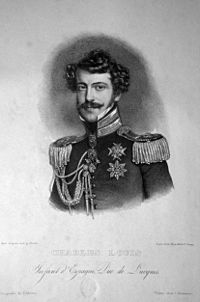
On March 13, 1824, Charles Louis's mother died, and he became Charles I, Duke of Lucca. He was twenty-five years old and inherited a small but well-managed duchy. However, he showed little interest in ruling. The difficult events of his early life had affected him deeply. He said that his life's storms and his inexperience made him lose faith in himself.
Charles Louis was not interested in government at first. He preferred to travel. For the first few years of his rule, he was often away from the duchy. His ministers, led by Ascanio Mansi, managed the government. From 1824 to 1827, Charles Louis traveled across Italy. He visited Rome and other courts. From 1827 to 1833, he traveled through Germany, where he owned two castles. He enjoyed life at the Austrian court. He also spent time in Berlin, Frankfurt, Prague, and other German cities.
In the early 1830s, Charles Louis started to take more interest in state matters. His duchy was not affected by the revolutions that happened in central Italy in 1831. In foreign policy, he refused to recognize King Louis Philippe of France, who came to power in 1830. He also supported the Carlists in Spain and the Miguelist cause in Portugal.
In 1833, Charles Louis returned to Lucca and offered a general pardon. This was different from other Italian states that chose to punish people. The same year, Thomas Ward, a former English jockey, arrived in Lucca. In a few years, he became Charles Louis's advisor and minister. Charles Louis studied and collected religious texts. He was interested in different religious practices. He even built a Greek Orthodox chapel at his villa. He also showed interest in Protestantism, which was not popular with other Catholic rulers.
Charles Louis made some popular changes to the government and finances. He encouraged education and medicine, helping to set up schools. These changes happened thanks to his minister Mansi while the duke was away. Charles disappointed his people who hoped for a return to an older constitution. He tried to copy things he saw abroad, even if they didn't fit Lucca. His love for travel made governing difficult. He often signed decrees without fully understanding the issues. The real power was with his minister Mansi. People said that Charles Louis was the Duke, but Mansi was the king.
After 1833, Charles Louis, who often needed money, traveled less. In 1836, he returned to Vienna. In 1838, he went to France and then to England, where he got into debt. In 1837, he allowed a casino to open. He also reformed the State Council and Council of Ministers. In 1840, his minister Ascanio Mansi died. Charles Louis then took more initiative, but his court attracted many different people, and Lucca became a safe place for liberals from other states. The economy of the duchy had been declining since 1830. In 1841, paintings from the Palatine Gallery had to be sold.
Charles Louis rarely saw his wife, who lived a quiet, religious life after 1840. He visited her but felt she lacked understanding. Charles Louis admired beautiful women. While in his Duchy, Charles preferred to stay in the countryside. In 1845, his son married Princess Louise Marie Thérèse d'Artois.
Under pressure from Austria, Charles Louis agreed to some land changes that would affect his future inheritance in Parma. By a treaty in 1844, he gave up his claim to the Duchy of Guastalla and lands east of the Enza River. These lands went to Modena, and he received Lunigiana in return. This treaty was kept secret for almost three years. When it became known, it made Charles Louis unpopular in both Lucca and Parma. Needing money, he claimed old tax credits. All these things led to general unhappiness. A liberal movement grew in Lucca, leading to protests in 1847. Charles Louis tried to keep control, but the unrest forced him to hide. On September 1, 1847, he signed some agreements. Three days later, he returned to Lucca and was welcomed. However, he could not handle the pressure and left for Modena on September 9. From there, he created a Council of Regency to rule. On October 4, he gave up his rule to the Grand Duke of Tuscany. Thomas Ward helped arrange this early handover. Charles Louis then left for Saxony, while his family went to live in Turin.
Duke of Parma and Final Years
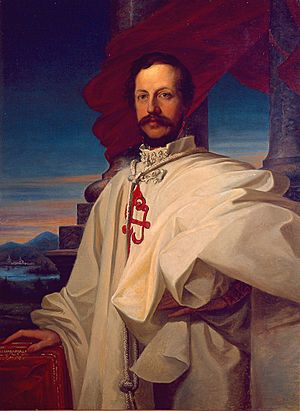
Charles Louis traveled from Modena to his German estates. Free from ruling, he wanted to enjoy life, travel, and study. However, he soon heard that Marie Louise, Duchess of Parma, was very ill. She died on December 17, 1847. He had to decide whether to accept the Duchy of Parma. At first, he wanted to avoid new responsibilities. But he accepted to protect his son's rights. On December 31, 1847, Charles Louis arrived in Parma and took the throne of his ancestors as Charles II. The Duchy of Lucca became part of Tuscany, and Parma lost Guastalla but gained Lunigiana.
Charles II was not well-received in Parma. He did not know the country or its people well. He lacked the strength and political skill to handle the difficult situation, which was much harder than in Lucca. Parma was controlled by Austria, so he was not free to follow his own ideas. He wrote to Ward, "It is better to die than to live like this." He felt like a prisoner in the palace and wanted to give up his throne.
In his first actions as ruler, he tried to organize the government. He also made a military agreement with Austria. A few months after he arrived, the 1848 revolution broke out in Parma. He had to choose between stopping the revolution or making changes. He chose to make changes and appointed a regency to create a constitution. He wanted to save the throne for his son. However, Piacenza had already asked to join Piedmont. On April 9, the regency became a temporary government. Only four months after becoming duke, Charles II was forced to flee Italy. He found safety in his castle in Saxony. On April 19, 1848, Charles gave up his throne to his son, who had also escaped.
During the First Italian War of Independence, the Austrian army defeated the troops of Charles Albert. In April 1849, Austrian troops occupied Parma and Piacenza. Charles II quickly tried to get his rights back over the Duchy. He took control of the government with Austrian help. Happy to secure the Duchy of Parma for his family, Charles finally resigned on March 14, 1849, in Saxony, giving up his throne to his son.
Life After Abdication
After giving up his throne, Charles Louis took the title of Count of Villafranca. Living as a private person, he spent his time on hobbies. He divided his time between Paris, Nice, and his castle in Saxony.
Always needing money, he sold his Austrian estate to his friend Thomas Ward. In 1852, he went to Spain to recognize his cousin Isabella II as the rightful queen. He started to return to Lucca, where people still liked their former ruler despite him selling the city. He was allowed to attend a family meeting in April 1853.
His only son, Charles III, was killed on March 27, 1854, at age 31. In 1854, Charles Louis moved to Paris. In 1856, he visited his son's tomb and saw his wife. His grandson, Robert I, who was ruling Parma with his mother as regent, lost his throne in March 1860 during the Italian unification. Charles Louis, unlike other dethroned Italian rulers, saw the unification of Italy as a good thing.
After 1860, Charles Louis could visit Italy more freely. He visited Lucca more often, staying in villas there. His wife, Maria Theresa, who lived a very private life as a nun, died on July 16, 1879. Charles Louis was in Vienna at the time. His great-granddaughter, Archduchess Louise of Tuscany, later described him in her writings. She said he was "one of the most amusing and original men." She mentioned he would adopt the local religion wherever he went, saying it helped him fit in.
Charles Louis died in Nice on April 16, 1883, at age 83. He was buried at the family's large property in Viareggio.
Images for kids
-
Coat of arms as Charles Louis, Duke of Lucca and Knight of the Order of Santiago (1824-1847)
See also
 In Spanish: Carlos II de Parma para niños
In Spanish: Carlos II de Parma para niños


